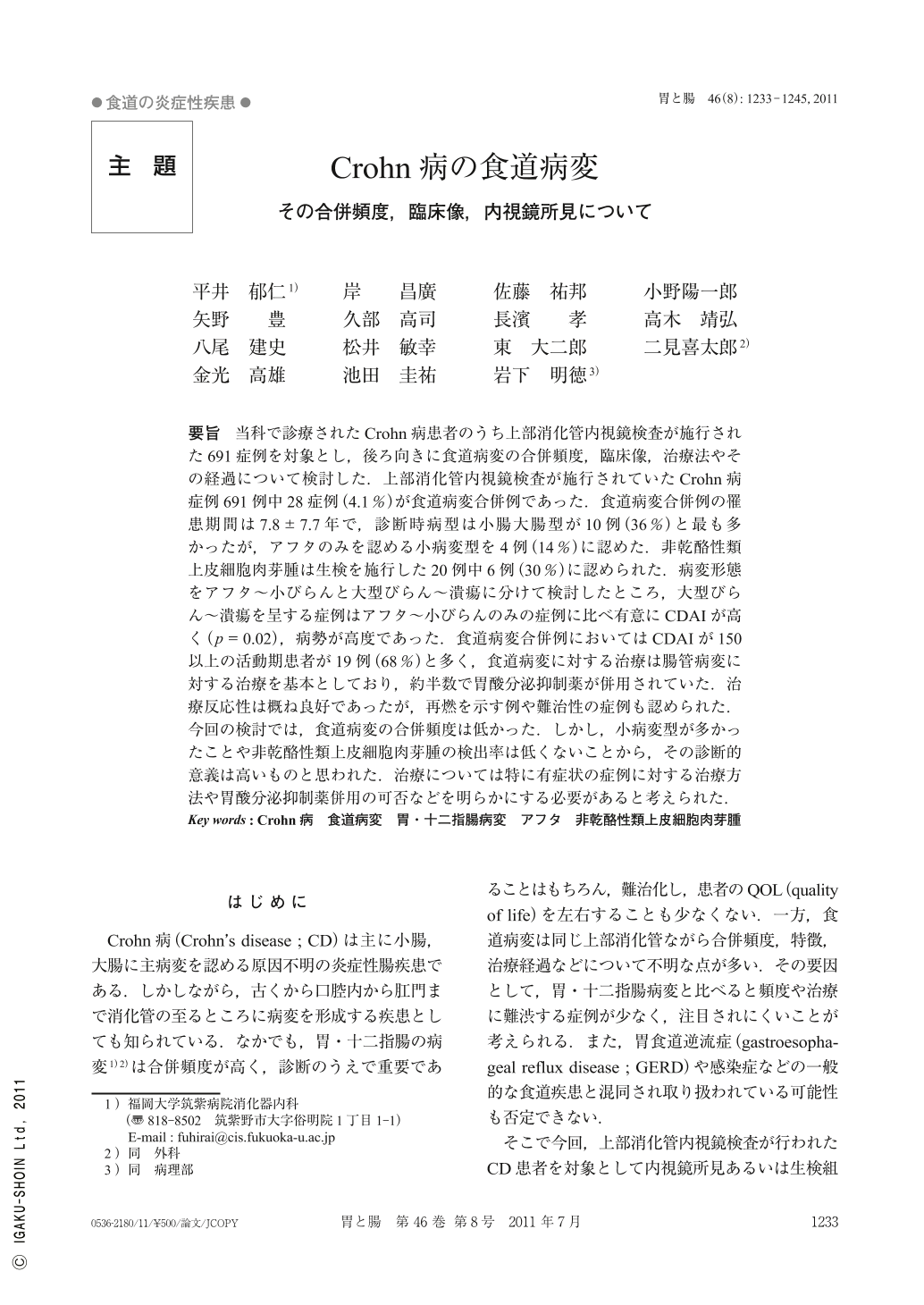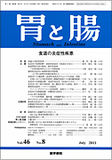Japanese
English
- 有料閲覧
- Abstract 文献概要
- 1ページ目 Look Inside
- 参考文献 Reference
- サイト内被引用 Cited by
要旨 当科で診療されたCrohn病患者のうち上部消化管内視鏡検査が施行された691症例を対象とし,後ろ向きに食道病変の合併頻度,臨床像,治療法やその経過について検討した.上部消化管内視鏡検査が施行されていたCrohn病症例691例中28症例(4.1%)が食道病変合併例であった.食道病変合併例の罹患期間は7.8±7.7年で,診断時病型は小腸大腸型が10例(36%)と最も多かったが,アフタのみを認める小病変型を4例(14%)に認めた.非乾酪性類上皮細胞肉芽腫は生検を施行した20例中6例(30%)に認められた.病変形態をアフタ~小びらんと大型びらん~潰瘍に分けて検討したところ,大型びらん~潰瘍を呈する症例はアフタ~小びらんのみの症例に比べ有意にCDAIが高く(p=0.02),病勢が高度であった.食道病変合併例においてはCDAIが150以上の活動期患者が19例(68%)と多く,食道病変に対する治療は腸管病変に対する治療を基本としており,約半数で胃酸分泌抑制薬が併用されていた.治療反応性は概ね良好であったが,再燃を示す例や難治性の症例も認められた.今回の検討では,食道病変の合併頻度は低かった.しかし,小病変型が多かったことや非乾酪性類上皮細胞肉芽腫の検出率は低くないことから,その診断的意義は高いものと思われた.治療については特に有症状の症例に対する治療方法や胃酸分泌抑制薬併用の可否などを明らかにする必要があると考えられた.
〔Background〕It is considered that involvement of the esophagus by CD(Crohn's disease)occurs infrequently. However, the true incidence and clinical course are not known because no large study has been done.〔Objective〕To clarify the incidence, clinical features, endoscopic findings and treatment outcome of the patients with esophageal involvement of CD.〔Patients and methods〕The subjects of this study were six-hundred and ninety one patients with CD who underwent UGE(upper gastrointestinal endoscopy)at our department at least once during follow-up. For analysis, we used the database to which almost all CD patients at our hospital had been registered. We investigated clinical features, endoscopic findings and clinical course using the database and medical records of the subjects retrospectively. We defined as esophageal lesions of CD as follows ; 1)longitudinal ulcer or cobble stone appearance,2)diffuse irregular or round shaped ulcer, aphthous lesions,3)longitudinal multiple aphthous lesions,4)any lesions with granulomas. We classified the esophageal lesions of CD into two types as aphthous lesions or small erosions(small lesions)and large erosions or ulcerations(large lesions).〔Results〕Among 691 patients with CD,28(14male,14 female, observation period : 7.8±7.7 years)had esophageal lesions according to our definition Therefore, the incidence of esophageal involvement in CD patients at our hospital was estimated as 4.1%(28/691). With regard to the disease type at diagnosis of CD, ileo-colitis type was most common, but four patients(14%)were aphthous type that is considered as the early phase of CD. Patients in the active phase(Crohn's disease activity index,CDAI>150)were seen in 19cases(68%). Of 28 patients,7(25%)had large lesions and 21(75%)had multiple small lesions showing longitudinal location. In pathological findings, granuloma was seen in 6 patients(30%)of 20 on whom esophageal biopsy had been performed endoscopically. The mean CDAI score of patients with large lesions was statistically higher than that of patients with small lesions(282.3±123.6 vs. 185.7±86.2, p=0.02). So we speculated that the activity of esophageal large lesions paralleled the disease activity. On the other hand, the esophageal small lesions seemed to have no relationship with the disease activity. Twenty-six patients(93%)had received treatment for active intestinal lesions of CD including intestinal resection or anti TNF-αantibody. The only remaining two patients had received particular treatments for esophageal involvements such as steroid therapy. The clinical outcome was rather good, and few patients showed recurrence of esophageal involvement. Histamin 2 antagonists and proton pump inhibitors were prescribed in 15 patients(54%). Although some patients showed good response to treatment, the effectiveness of these medicines were not proved in this present study.〔Conclusions〕Esophageal involvement of CD is a rare entity. However, these lesions have specific endoscopic and pathological findings. Because it has potential for diagnosis of CD, we need to evaluate these lesions by UGE correctly.

Copyright © 2011, Igaku-Shoin Ltd. All rights reserved.


